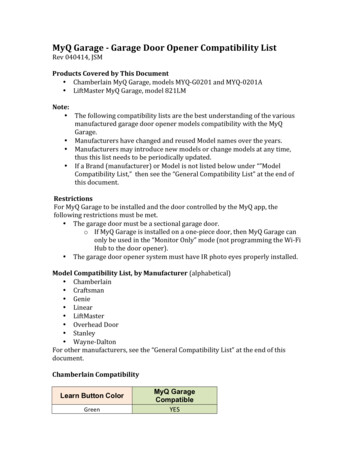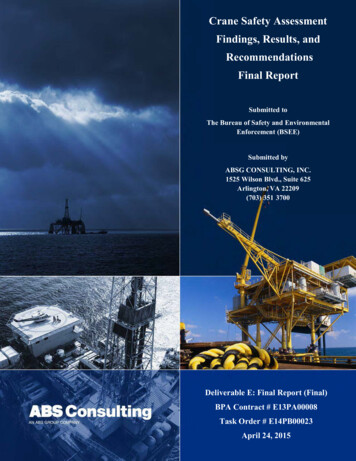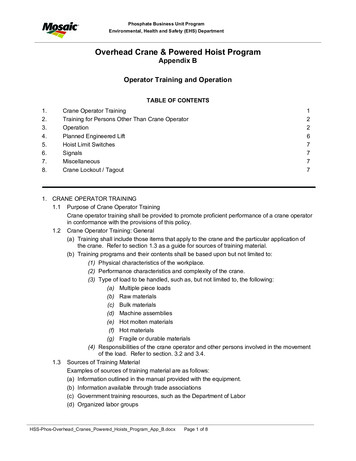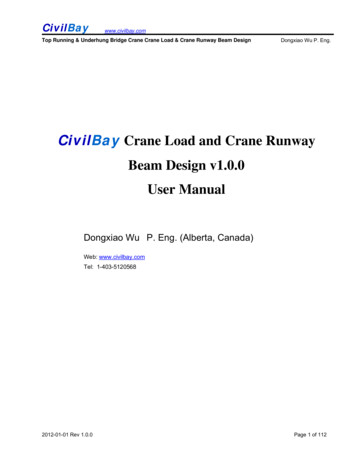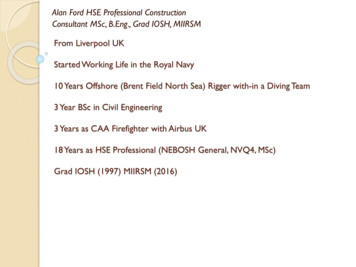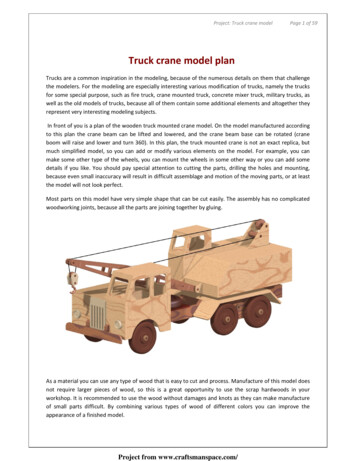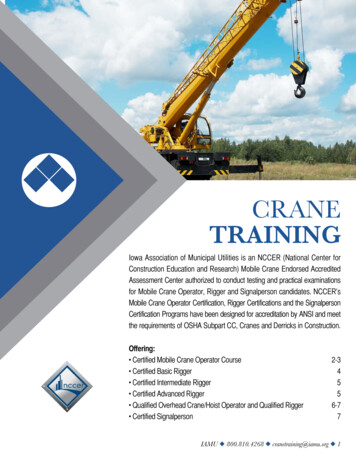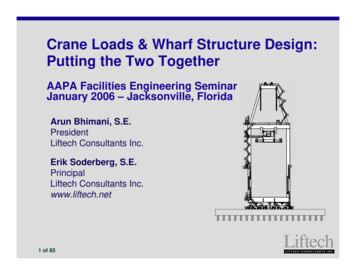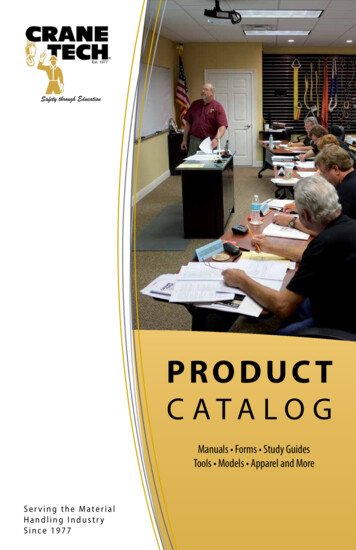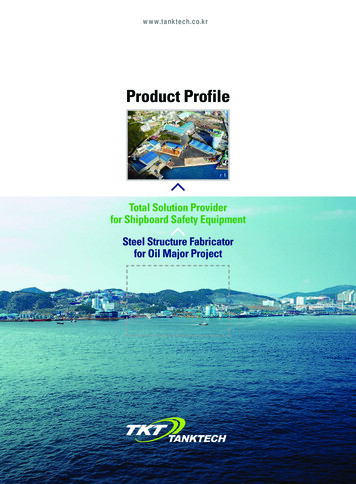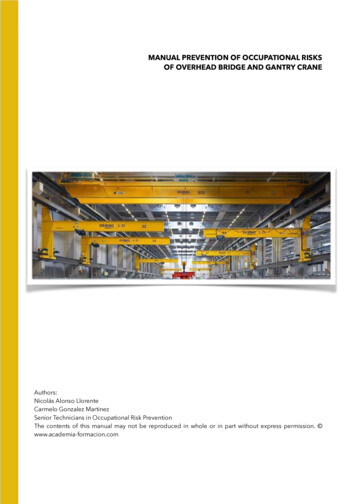
Transcription
MANUAL PREVENTION OF OCCUPATIONAL RISKSOF OVERHEAD BRIDGE AND GANTRY CRANEAuthors:Nicolás Alonso LlorenteCarmelo Gonzalez MartinezSenior Technicians in Occupational Risk PreventionThe contents of this manual may not be reproduced in whole or in part without express permission. www.academia-formacion.com
INDEXMODULE IPREVENTION AND LEGISLATIVE FRAMEWORK. BASIC RIGHTS AND DUTIES1.1.- Law on the Prevention of Occupational Risks1.2.- Basic rights of workers1.3.- Duties of workers1.4.- Employer's obligations1.5.- Other provisions1.6.- Reference standardsMODULE IITHE CRANE BRIDGE2.1.- General definition of a crane bridge2.2.- Main components2.3.- Handling of the Bridge Crane2.4.- Control verification with button panel2.5.-Safety elements at work with a crane bridge2.6.- Lifting accessories, slings, rigging and seesaws2.7.- Joining elements2.8.- The Hooks2.9.- Crane Bridge Maintenance2.10.- Safety in the maintenance of Bridge Cranes2.11.- Participation of the crane operator in the maintenance of the Bridge Crane2.12.- Maintenance Plan for Bridge Cranes2.13.- Inspection of the Bridge CranesAnnex. Checklist - Crane Overhauls (Guidance Table)
MODULE IIIRISKS INHERENT IN THE BRIDGE CRANE AND PREVENTIVE MEASURES3.1.- Risks inherent to the Bridge Crane3.2.- Preventive measures for the handling of Bridge Cranes3.3.- Preventive measures for the handling of Auxiliary Elements3.4.- Advice on the use of Textile Slings3.5.- Use by the OperatorMODULE IVCOLLECTIVE AND INDIVIDUAL PROTECTIONS4.1.- Collective protections4.2.- Personal Protection Equipment4.2.1.- Definition of personal protective equipment (PPE)4.2.2.- Criteria for the use of PPE ś4.2.3.- Conditions to be met by PPIs ś4.2.4.- Types of PPE category4.2.5.- Obligations of workers and managersMODULE VSAFETY SIGNS5.1.- Forms of Signaling5.1.1.- Safety Colors5.1.2.- Signalling in the form of a Panel5.1.3.- Light or acoustic signals5.1.4.- Verbal Communication5.1.5.- Gesture Signaling
MODULE IPREVENTION AND LEGISLATIVEFRAMEWORK BASIC RIGHTS ANDDUTIES
UNIT1.1.- LAW ON PREVENTION OF OCCUPATIONAL RISKSThe legislation in force on the prevention of occupational risks is numerous andextensive due to the powers of the different administrations in this area, which hasmeant an important change in society's mentality since it no longer seeks only to reducethe number of occupational accidents, but the great objective of companies andworkers is to promote a culture of prevention of occupational risks in order to improvethe quality and productivity of companies while improving the health and safety ofworkers and, ultimately, their well-being.Starting from the fact that current legislation obliges public authorities to ensure healthand safety in the workplace, the development of policies to protect both the health andsafety of workers by preventing risks arising from their jobs is the main need in thisrespect. To this end, Law 31/1995 of 8 November on the Prevention of OccupationalRisks provides the general framework for the development of the various preventiveactions to be carried out, always in harmony with European Union regulations.The Occupational Risk Prevention Law establishes the necessary guarantees andresponsibilities to ensure that the level of protection of the safety and health of workersis adequate and sets the legal framework from which the regulatory standards willspecify the more technical aspects.The following is a literal list of the articles of the Occupational Risk Prevention Lawrelated to the rights and duties of workers as well as the obligations of employers.
UNIT1.2.- BASIC WORKERS' RIGHTSArticle 14.1"Workers have the right to effective protection in the field of occupational safety andhealth, from which derives a corresponding duty on the part of the employer to protectworkers against occupational hazards".Article 17"To have at their disposal the work equipment and personal protection meansappropriate to the performance of their duties"Article 18"To be informed of the risks to safety and health at work, of the protection andprevention measures applicable to such risks, and of the measures taken in the event ofan emergency".Article 18"To be consulted and involved in all matters affecting occupational safety and health"Article 19"To have sufficient and appropriate theoretical and practical training in preventivematters, focused on the workplace"Article 20"To have the emergency measures in accordance with the size and activity of thecompany"
Article 21"In case of serious and imminent risk, the activity shall be stopped and, if necessary, theworkplace shall be immediately abandoned"Article 22"To have the measures of surveillance and control of health according to the risks"Article 25"To ensure the protection of workers who, because of their own personal characteristicsor known biological condition, including those who are recognised as having a physical,mental or sensory disability, are particularly sensitive to the risks arising from their work".
UNIT1.3.- DUTIES OF THE WORKERSArticle 29This article deals with the duties of workers with regard to risk prevention.Article 29.1"It is the responsibility of each worker to ensure, in accordance with his possibilities andby complying with the preventive measures adopted in each case, his own safety andhealth at work and that of other persons who may be affected by his professionalactivity, because of their acts and omissions at work, in accordance with their trainingand the instructions of the employer.In particular, workers shall, in accordance with their training and the employer'sinstructions:1. Make appropriate use, in accordance with their nature and the foreseeable risks, ofthe machinery, apparatus, tools, dangerous substances, transport equipment and, ingeneral, any other means by which they carry out their activity.2. Use correctly the protective means and equipment provided by the employer, inaccordance with the instructions received from the employer.3. Not to put out of operation and to use correctly the existing safety devices or thosethat are installed in the means related to their activity or in the workplaces where it takesplace.4. Immediately inform their direct superior and the workers designated to carry outprotection and prevention activities or, where appropriate, the prevention service, of anysituation which, in their opinion, involves a risk to the safety and health of workers onreasonable grounds.5. Contribute to the fulfilment of the obligations laid down by the competent authorityin order to protect the safety and health of workers at work.6. Cooperate with the employer so that the employer can ensure that workingconditions are safe and do not pose a risk to the safety and health of workers".
UNIT1.4.- EMPLOYER'S OBLIGATIONSThis implies a business commitment to safeguard the health and safety of the workers atits service. The Law establishes specific obligations for all employers, which can be oftwo kinds:‣ Organisational: the obligations that refer to how the employer must organisepreventive activities.‣Operativas: the concrete actions of a technical nature: risk assessment, training andinforming workers, etc.The main preventive activities to be developed in the companies are the following: To draw up the Prevention Plan. Organization and establishment of the preventive structure. Ensure the consultation and participation of workers. To carry out the evaluation of risk factors and the planning of preventive activity. To design, apply and coordinate the plans and programmes of preventive action. Train and inform workers. Investigate and analyse accidents at work. Provide first aid, assistance and support in the preparation of emergency measures. To carry out health surveillance of workers in relation to risks arising from work. To apply specific regulations, in addition, to carry out the coordination of businessactivities, the control of work equipment and personal protection equipment, etc.
Prepare and keep at the disposal of the labour authority the following documentation: Risk assessment. Prevention Plan. Protection and prevention measures and protection materials. Results of the periodic controls. Controls of the state of health of the workers and conclusions obtained from them. List of occupational accidents and professional illnesses that have caused incapacityfor work of more than one day.Article 15"The employer shall implement the measures which constitute the general duty ofprevention, in accordance with the following general principles: Avoiding risks. Assess the risks that cannot be avoided. Combat risks at source. Adapt the work to the person. Take account of technical developments. Replace the dangerous with the less dangerous or no risk. Plan prevention. Adopt measures that put collective protection before individual protection. Give appropriate instructions to workers.
UNIT1.5.- OTHER PROVISIONSFinally, we will also cite literally, texts of Royal Decree 1215/1997 of 18 July 1997 directlyrelated to work equipment for lifting loads, since they contain the minimum health andsafety provisions for the use of this work equipment used by workers (overhead cranes,handling equipment, etc.).
ANNEX I2. Minimum requirements for work equipment for lifting loads:(a) Work equipment for lifting loads must be firmly installed in the case of fixedequipment, or have the necessary components or conditions in other cases, to ensure itsstrength and stability during use, taking account in particular of the loads to be liftedand the stresses induced at the points of suspension or attachment to structures.(b) Machinery for lifting loads must have a clearly visible indication of its nominal loadand, where appropriate, a load plate indicating the nominal load for each configurationof the machinery.Lifting accessories must be marked in such a way that the essential characteristics forsafe use can be identified.If work equipment is not intended for lifting workers and there is a possibility ofconfusion, appropriate signs must be visibly affixed.(c) Permanently installed work equipment must be installed in such a way as to reducethe risk of the load falling, being released or being unintentionally diverted in adangerous manner or otherwise striking workers.(d) Machinery for the lifting or moving of workers must have the appropriatecharacteristics1º prevent, by means of appropriate devices, the risk of falling from the carrier,where such risks exist2º avoid the risk of the user falling from the carrier, where such risks exist3º Avoid the risks of crushing, entrapment or impact of the user, in particularthose due to incidental contact with objects.4º Guarantee the safety of workers who, in the event of an accident, are blockedin the cabin and allow their release.If for reasons inherent to the place and the unevenness, the risks foreseen in theprevious paragraph 1º cannot be avoided by means of any safety device, a cable with areinforced safety coefficient must be installed, the good condition of which will bechecked every day of work.
ANNEX II3. Conditions of use of work equipment for lifting loads.1. General:(a) Demountable or mobile work equipment used for lifting loads must be used in sucha way as to ensure the stability of the equipment during use under foreseeableconditions, taking account of the nature of the ground.(b) The lifting of workers is permitted only by means of work equipment and accessoriesprovided for the purpose.However, where, exceptionally, work equipment not intended for that purpose is to beused, appropriate measures must be taken to ensure the safety of workers and toprovide adequate supervision.While workers are on work equipment designed for lifting loads, the control positionmust be occupied at all times. Workers being lifted must have a safe means ofcommunication and provision must be made for their evacuation in the event of danger.(c) Unless necessary for the proper execution of the work, measures must be taken toavoid the presence of workers under suspended loads.The passage of loads over unprotected workplaces normally occupied by workers shallnot be permitted. If this is not possible, because it cannot be guaranteed that the workwill be carried out correctly in any other way, appropriate procedures must be definedand implemented.(d) Lifting accessories must be selected on the basis of the loads to be handled, thepressure points, the coupling device and the atmospheric conditions, and takingaccount of the method and configuration of the lashing. Lifting accessory assembliesmust be clearly marked so that the user is aware of their characteristics if they are notremoved after use.(e) Lifting accessories must be stored in such a way as to prevent damage ordeterioration.
2. Work equipment for lifting non-guided loads.(a) If two or more items of work equipment for lifting non-guided loads are installed orassembled on a site in such a way that their fields of action overlap, appropriatemeasures must be taken to prevent collisions between the loads or the items ofequipment themselves.(b) When using mobile work equipment for lifting non-guided loads, measures must betaken to prevent the equipment from rolling, tipping and, where appropriate, moving orslipping. Checks must be made to ensure that these measures are carried out correctly.(c) If the operator of work equipment for lifting non-guided loads cannot observe thefull path of the load either directly or by means of auxiliary devices providing usefulinformation, a signalman must be designated in communication with the operator toguide him and organisational measures must be taken to prevent collisions of the loadwhich could endanger workers.(d) Work must be organised in such a way that, while a worker is hanging or unhanginga load by hand, he can carry out these operations safely, in particular by ensuring that heretains direct or indirect control of them.(e) All lifting operations must be properly planned, properly monitored and carried outwith a view to protecting the safety of workers.In particular, when two or more pieces of work equipment for lifting non-guided loadshave to be lifted simultaneously, a procedure must be drawn up and implemented toensure that operators are properly coordinated.(f) If work equipment for lifting non-guided loads cannot maintain the loads in the eventof a partial or total failure of the energy supply, appropriate measures must be taken toavoid exposing workers to the corresponding risks.Suspended loads must not be left unattended unless access to the danger zone isimpossible and the load has been safely suspended and is maintained in completesafety.(g) The use of work equipment for lifting non-guided loads in the open must bestopped when the weather conditions deteriorate to the point of jeopardisingoperational safety and thus putting workers at risk. Adequate protection measures, inparticular to prevent work equipment from tipping over, must be taken to avoid risks toworkers.
UNIT1.6.- REFERENCE STANDARDS Texto Refundido de la Ley del Estatuto de los Trabajadores, aprobado por RealDecreto legislativo1/1995 de 24 de marzo. Law on the Prevention of Occupational Risks (Law 31/1995 of 8 November 1995,approving the Law on the Prevention of Occupational Risks. Royal Decree 39/1997 of 17 January 1997, approving the Regulations on PreventionServices. Community Directive 89/391/EEC of 12 June 1989 on the introduction of measures toencourage improvements in the safety and health of workers at work. Royal Decree 485/1997 of 14 April 1997 on minimum provisions for health and safetysigns in the workplace. Royal Decree 486/1997, of April 14, establishing minimum health and safetyprovisions in the workplace. Royal Decree 487/1997, of 14 April, on minimum health and safety requirements forthe manual handling of loads that pose risks, particularly to workers' backs. Real Decreto 488/1997, de 14 de Abril, (B.O.E. 23/IV/97) sobre disposiciones mínimasde Seguridad y Salud relativas al trabajo con Equipos que incluyen Pantallas deVisualización. Royal Decree 664/1997, of 12 May, (B.O.E. 24/V/97) on the protection of workersagainst risks related to exposure to biological agents at work. Royal Decree 665/1997, of 12 May, (B.O.E. 24/V/97) on the protection of workersagainst risks related to exposure to carcinogens at work. Royal Decree 1215/1997 of 18 July 1997, establishing the minimum health and safetyrequirements for the use of work equipment by workers. Royal Decree 773/1997 of May 30, 1997 on minimum health and safety provisions forthe use by workers of personal protection equipment.
MODULE IITHE CRANE BRIDGE
To understand what bridge cranes are, how they work, etc., we must askourselves:What is meant by load?Load is any material object that can be lifted by lifting equipment.What is meant by work equipment or machinery for lifting and transporting loads?We must understand that they are work equipment with sufficient capacity to carry outlifting, transport and storage operations of loads including the necessary elements for: Anchoring Fixing Work Team Support
What do we mean by lifting accessories?They are components, without being integral parts of the work equipment or liftingmachine, that make it possible to grip or tie up the load for handling.
UNIT2.1.- GENERAL DEFINITION OF A BRIDGE CRANEThe bridge cranes, they're machines.Due to the different types of movements that the work team has, they are used to lift,transport and deposit loads (materials, parts, metal coils, .) both for indoor work(industrial warehouses, production halls, workshops, etc.) and outdoor work (naval ports,outdoor storage, ).In both cases, the lifting, transport and storage of loads can take place during theproduction or storage process.
UNIT2.2.- MAIN COMPONENTS Structure or chassis Track and caster wheels. Bridge longitudinal travel gear. Transverse movement of the carriage. Hook lift. Control devices.Mainly, it is a metallic structure formed by a raised beam or by several metallicbeams forming a "U" being this structure necessarily rigid and non-deformable.This metal structure is moved by a system of wheels mounted on side rails, which canbe moved by one or more electric motors.Supported by the metal structure and with the capacity to move along it, there is a selfpropelled trolley with a hoist to lift the loads.The rails used for the movement (translation movement) of the bridge along theroadway are approximately at the same height as the self-propelled trolley, this beingthe maximum working height of the machine.
UNIT2.3.- HANDLING OF THE BRIDGE CRANEThe crane can be operated either from the cabin or from the ground. In this case, thebridge crane can be controlled with a pendant or a remote control pendant.If the crane is controlled from the cabin, this cabin will be added to the metal structure(bridge), although it is becoming increasingly common in this type of machine for it tobe controlled by means of a wired or wireless remote control.The operator's cabin on the bridge crane itself offers a better view of the loads to behandled and is mainly suitable for handling bulky loads.Cable or wireless remote controls are generally used to work with less bulky loads.Working with this type of device requires the operator to accompany the load at alltimes.
UNIT2.4.- CONTROL VERIFICATION WITH BUTTON PANELBefore starting the machine it will be necessary to check: that there are no obstacles in the running area That the team responds to the controls Test all movements without load and at low speed Brake operation Lifting Limiter (Limit Switch)At the end of the day it will be necessary to check: that the buttonhole is located in the place provided That no suspended loads are abandoned That the hook is in the upper third of his career.
UNIT2.5.- SAFETY ELEMENTS IN WORKS WITH BRIDGE CRANEControl pendant with emergency stop device. The emergency stop is clearlyidentified and cannot be unintentionally reset.Limit switches for both lifting movements (upper and lower), trolley travelmovements (maximum and minimum) and bridge travel movements (start and end oftravel rails) Its purpose is to slow down or suppress a certain movement when there maybe a collision between two parts of the crane, or between the crane and the load.Shock absorbers, prevent the derailment of the bridge crane.Overload limiters acting on the lifting mechanism. They can be manual(tensiometric) or electronic, the latter offering high precision and safety. Their purposeis to prevent any movement when there is an overload on the load to be transported.Brakes. They will act on mechanized surfaces being able to dissipate the heat producedduring their operation. We identify brakes for the different mechanisms of movement ofthe bridge crane being these: Lifting mechanisms: Each mechanism must be equipped with two brakes capable ofholding, each one of them, one and a half times the admissible load. Mecanismo travel mechanisms: Each mechanism must be equipped with an electrohydraulic brake to reduce speed and movement. Mecanismo steering: Each trolley must be equipped with means to slow down, stopand hold in the position required by the maneuver.
Safety latches on load lifting hooksMain switch, cuts off the power supply. Only to be used in case of severe anomaliesand/or emergencies.Grounding. All the electrical elements of the work equipment must have an efficientearthing system.Collective protections in overhead passages such as guardrails.Individual protections, safety harness, safety helmet, protective gloves, etc.Nominal lifting load visible on the bridge crane itself.
UNIT2.6.- LIFTING ACCESSORIES, SLINGS, RIGGING AND SEESAWSLifting accessories, slings, can be made up mainly of ropes, cables or chains, but canalso be flat slings made of synthetic fibre fabric.THE ROPESThese are textile elements whose diameter must not be less than 8 mm. For liftingloads, they must be made of natural textile fibres such as hemp, sisal, etc. or syntheticfibres such as polyamide, polyester, polypropylene or polyethylene.The breaking load of a rope depends on its diameter, on the quality and nature of thefibres used for its manufacture, and on the state of conservation (or deterioration) inwhich it is found. A rope deteriorates faster the smaller its diameter.
THE CABLESThey are metallic elements formed by several cords arranged helically in one or severalsuperimposed layers, around a core that can be textile, metallic or mixed.The strands are made up of one or more steel wires also arranged helically in one ormore layers.The breaking load of a rope depends on the number of wires in it, the cross-section ofthe wires and the quality of the steel.Normally the cables are supplied lubricated, and to guarantee their maintenance it issufficient to use the type of grease recommended by the manufacturer.In the case of a broken cord, abnormal and localised reduction in the diameter of thecable, the existence of knots, etc, the cable will be rejected.
THE CHAINSThey are metal elements that are characterized by the ability to form very small anglesbetween the links, although unlike the two previous lifting accessories, the chains areheavier and less resistant to cold.The working load capacity of a sling, of whatever type, will depend on the angle formedby the branches supporting the load. Thus, for a two-branch sling, the load capacitydecreases as the angle formed by its branches increases.
When using slings, the following aspects must be taken into account: Knots decrease the strength of the sling by 30-50%. Welding of terminals, rings or eyelets reduces the resistance by 15 - 20 %. Joints using cable ties reduce the strength by 20 %. Avoid, if possible, an angle between sling strands of more than 90 . Strings of different slings must not be mounted on top of each other on the hook andmust never be supported on sharp edges. Before lifting the load, it should be raised slightly above ground level (to a height ofless than 10 cm), and the slings should be tensioned manually to check that the load isproperly secured and balanced. During the lifting operation, the slings must not be touched and workers must be keptaway from the load.THE BALANCESThey are steel profiles with eyelets or hooks on which several slings are placed.Their use reduces the length of the slings and thus the need for height of the liftingequipment.
UNIT2.7.- CONNECTING ELEMENTSTHE ARGULLSThey are made of forged steel and have a bracket and a tight shaft, which is normallythreaded at one end of the bracket, preventing it from being opened.THE RINGSThey have various shapes, although their straight section is usually circular.
UNIT2.8.- THE HOOKSThese are metal elements, normally made of steel or cast iron, which facilitate therapid hooking of loads, but are exposed to the risk of unhooking. For this reason, onlyhooks equipped with a safety device against accidental unhooking should be used.REMEMBER, a hook should not be deformed in an attempt to increase its loadcapacity. A bent hook must be destroyed.During the hooking of the load: Stresses should be supported by the hook seat and not by the peak. The safety device must be checked for proper operation. Swaying of the load must be avoided.
UNIT2.9.- BRIDGE CRANE MAINTENANCEMaintenance, testing and inspection of these machines must be carried out byqualified and sufficiently trained personnel.A log book must be kept for each bridge crane, in which dates, checks and faults arerecorded.
UNIT2.10.- SAFETY IN THE MAINTENANCE OF CRANE BRIDGESThe installation of a bridge crane shall be carried out in an area where it does not hinderthe movement or work of other bridge cranes that may operate on the same runways. Tothis end, the bridge crane and the working area must be isolated by means of signs andstops on the crane runways.The main safety measure is to switch off the bridge crane completely by means of themain switch. If this is not possible, the controls of the crane bridge will be blocked,preventing anyone from acting on them or the work equipment from being accidentallyswitched on.
UNIT2.11.- PARTICIPATION OF THE CRANE OPERATORIN THE MAINTENANCE OF THE BRIDGE CRANE Revisio visual of elements that are subjected to stress. Review to be carried out daily. Brake check. Checking to be carried out daily. Checking for possible deviations in machine operation. Checking atto perform daily. Checking of the correct functioning of the safety latch on the hook. Checking to becarried out weekly.
UNIT2.12.- MAINTENANCE PLAN FOR BRIDGE CRANESCompanies should establish preventive maintenance programs based on themanufacturer's recommendations or the experience of qualified persons.Preventive maintenance of bridge cranes should include the identification of partssubject to wear or critical parts.The main spare parts for bridge cranes are listed below:1. Brake discs, coils and/or brake mechanisms.2. Safety limits.3. Contactors, contact kits.4. Jumper and carriage wheels.5. Lifting cable.6. Translation and hoisting motors.7. HookIMPORTANT!!Deteriorated parts must be replaced by qualified personnel and it is advisable to useoriginal spare parts to ensure their interchangeability and the correct functioning of theparts.
UNIT2.13.- INSPECTION OF THE BRIDGE CRANESThe frequency of inspections to be carried out on bridge cranes will depend on the typeof service to which they are subject, mainly because there are no specific regulationsgoverning this type of work equipment.Cranes used permanently or continuously will require more attention than those usedsporadically.It is recommended to carry out periodic inspections/revisions (daily and/or monthly) thatinclude1. Visual inspection of the cables to detect possible breaks or damage to the cables.2. Visual inspection of the hook to detect possible deformation, breakage or excessivewear.3. Checking of lifting limits (upper and lower) and travel limits.4. Check for abnormal noise or vibration.IMPORTANT! These last four points should be carried out before the operator uses thebridge crane, in each corresponding shift or working day, as they are considered to beof safety.They should be inspected annually (before normal or regular operation) by qualifiedpersonnel:1. The state of the connections, tightening of nuts, bolts, etc.2. The breakage, wear, deformation or formation of rust on rails, wheels, etc.3. The breakage, wear or mechanical deformation of shafts, bearings, chains, etc.4. Wear and tear of brakes.5. Condition of the winding drum, pulleys, etc.6. The correct functioning of the motors.7. The state of the hook and its accessories.8. The electrical installation of the machine (wear on contactors, relays, etc.)
MODULE IIIINHERENT HAZARDSTO THE CRANE BRIDGEAND PREVENTIVE MEASURES
In this training manual, it is intended that in addition to having the necessaryknowledge of the structure and basic operation of a bridge crane, the main risks ofthe bridge crane operator's workplace are also covered.Specific and non-specific professional risks will be dealt with, and the tasks or areaswhere this type of risk is most likely to occur will be explained, as well as the actions orpreventive measures to be taken to avoid these risks leading to accidents at work.Before dealing with the risks to which the bridge crane operators are exposed, as well asthe personnel who may be within the radius of action of the work equipment, we shouldask ourselvesWhat are the risks and why do they exist?The law of prevention of labour risks defines them as:"the possibility that a worker, in the course of his normal working day, suffers acertain damage"We must first understand that if the damage to the worker can occur, it will be directlyrelated to the sources of risk associated with th
2.5.-Safety elements at work with a crane bridge 2.6.- Lifting accessories, slings, rigging and seesaws 2.7.- Joining elements 2.8.- The Hooks 2.9.- Crane Bridge Maintenance 2.10.- Safety in the maintenance of Bridge Cranes 2.11.- Participation of the crane operator in the maintenance of the Bridge Crane 2.12.- Maintenance Plan for Bridge .
